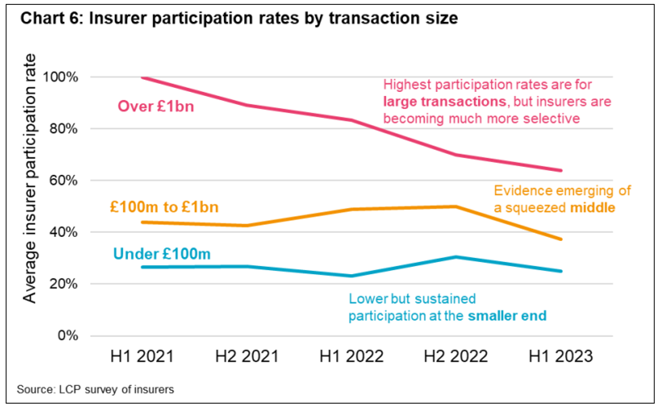Seismic shift
as number of DB schemes seeking risk transfer to insurers jumps by over 50% – LCP
Media centre
16 October 2023
Analysis from LCP in their latest report shows that the number of UK private sector DB schemes fully funded on buy-out has swelled to 20%, equating to 1,000 schemes and c£275bn of assets out of the £1,400bn total in UK DB schemes.
This has led to a ‘seismic shift’ with a large rise in the number of schemes seeking to transfer to insurers - there was an increase of over 50% in the number of schemes approaching insurers for buy-in/out quotations compared to a year earlier.
LCP’s analysis projects that a further 1,250 schemes will reach full funding on buy-out within the next five years - further accelerating the boom in the pension buy-in and buy-out market. Volumes of assets transferring to insurers over the next five years are projected to reach up to £360bn. This represents a substantial uptick from historic levels, with volumes over the past five years totalling £155bn.
Early indications of the seismic shift can be seen in the record £21.2bn of assets transferred to insurers in the first half of 2023, putting the year on track to exceed the previous record of £43.8bn of buy-ins/outs in 2019.
Amidst the booming demand, insurers have been scaling up through extra people, improved technology, extended asset sourcing and streamlined internal processes. Pricing has remained highly competitive at all size levels, but evidence shows that insurers are becoming more selective, with a 20% reduction in the proportion of insurers that agree to provide a quotation.
LCP’s report also analysed how different market segments are performing:
- Very large schemes have seen the biggest growth, with the number of £1bn plus transactions approaching insurers increasing by 2-3 times in the first half of the year. Whilst larger schemes are still well-placed to secure insurer engagement, they can no longer assume that all insurers will quote on their process.
- Smaller transactions continue to be relatively well-served, with several insurers allocating dedicated capacity. Despite a significant increase in quotation requests, insurer participation rates have remained relatively stable over the past two years.
- The market segment facing the greatest challenge is currently the ‘squeezed middle’ – mid-sized deals of between £100m and £1bn – who haven’t benefited from the streamlining for smaller schemes and are having to compete with the many large transactions. A chart of insurer participation rates by size is included below.

LCP sees potential levers to alleviate these pressures. M&G re-entered the market in September 2023, and further new entrants are expected over the next year. This will help add much-needed capacity to the market. The reforms to Solvency II come into effect over 2023 and 2024, which should increase capacity further.
Charlie Finch, Partner in LCP’s de-risking team, commented: “There has been a seismic shift in the DB pension landscape in the past year as the number of schemes seeking to transfer to insurers has surged on the back of tumbling buy-out shortfalls. The record for the largest scheme to achieve full insurance has been broken twice this year already – once by RSA at £6.5bn in February and then by the British Steel Pension Scheme at £7.5bn in May.
“Our analysis shows that this trend is only likely to accelerate with nearly half of the c5,000 DB schemes projected to be fully funded on buy-out within five years.”
Imogen Cothay, Partner in LCP’s de-risking team, added: “Insurers are rising to this challenge, and despite short-term resourcing pressures, insurers are confident about their capacity to support record-breaking demand over the coming years.”
“As activity ramps up, insurers are being more selective on which schemes they work with, but we are still seeing strong competition, even for smaller transactions. That being said, schemes that wish to target insurance need to be strategic in their approach. The balance of power in the market has shifted, and schemes need to be able to justify to insurers through targeted preparation and by agreeing to a suitable route to market, why those insurers should participate in their transaction processes.”

